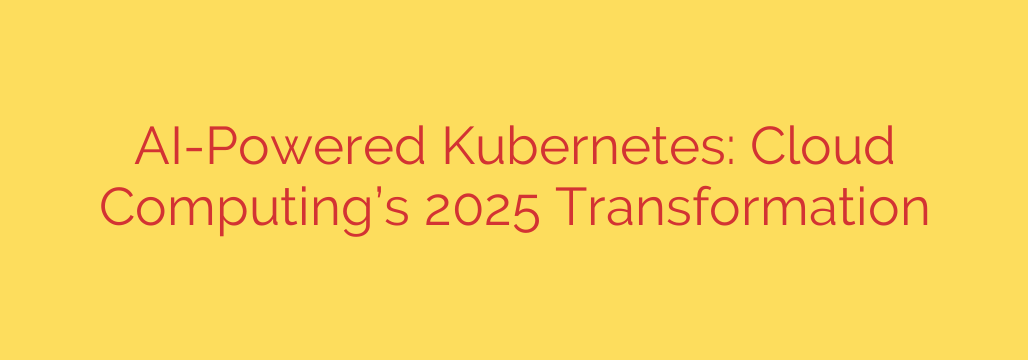
AI and Kubernetes: How Intelligent Automation is Shaping the Future of Cloud Computing
Kubernetes has firmly established itself as the gold standard for container orchestration, providing a powerful framework for deploying, scaling, and managing modern applications. Yet, as systems grow in complexity, the operational overhead of managing these intricate environments can become a significant challenge. This is where Artificial Intelligence (AI) is stepping in, poised to transform Kubernetes from a powerful tool into an intelligent, autonomous platform.
The integration of AI into the cloud-native ecosystem isn’t a futuristic concept—it’s happening now, setting the stage for the next evolution of cloud computing. By leveraging AI and machine learning, we are moving beyond simple automation and into the realm of intelligent orchestration, where systems can predict needs, heal themselves, and optimize for performance and cost without constant human intervention.
The Power Couple: Why AI and Kubernetes are a Perfect Match
Kubernetes environments generate a massive amount of telemetry data—logs, metrics, and traces that describe the health and performance of every component. For a human operator, sifting through this data firehose is nearly impossible. For an AI model, however, this data is the fuel for learning, predicting, and acting.
This symbiotic relationship is creating a new paradigm for cloud management, often referred to as AIOps (AI for IT Operations). Here’s how this powerful alliance is revolutionizing key aspects of Kubernetes management.
Intelligent Resource Allocation and Scheduling
In a standard Kubernetes setup, the scheduler places workloads (pods) onto nodes based on predefined rules and resource requests. This works well, but it isn’t always the most efficient.
AI introduces a new level of sophistication. By analyzing historical workload patterns, resource consumption, and even application-specific performance metrics, an AI-powered scheduler can make far more intelligent decisions.
- Benefit: It can place a high-priority, latency-sensitive service on a high-performance node while moving a batch-processing job to a cheaper, spot-instance node. This leads to smarter, more cost-effective resource utilization and ensures critical applications always have the resources they need.
Predictive Autoscaling for Flawless Performance
Traditional Kubernetes autoscaling is reactive. The Horizontal Pod Autoscaler (HPA), for instance, adds more pods only after CPU or memory usage has already crossed a set threshold. This can lead to a lag time where users experience slow performance before the new resources come online.
Predictive autoscaling flips the script. By analyzing historical traffic data (e.g., daily peaks, seasonal trends from a marketing campaign), AI models can anticipate demand spikes before they happen.
- Benefit: The system can scale up proactively, ensuring resources are ready the moment they’re needed. This effectively eliminates performance bottlenecks and reduces over-provisioning, as you no longer need to keep extra capacity “just in case.”
Automated Security and Anomaly Detection
Security in a dynamic, distributed environment like Kubernetes is a major challenge. Threats can emerge from anywhere, and tracking every network call and process manually is not feasible.
AI-driven security tools continuously monitor the behavior of the entire cluster. They establish a baseline of what “normal” activity looks like and can instantly flag any deviations.
- Benefit: This could be an unrecognized process running in a container, unusual outbound network traffic, or an API call that deviates from the norm. AI helps build a proactive, self-defending security posture, identifying and even isolating threats in real-time before they can cause significant damage.
Actionable Security Tip: To prepare for AI-driven security, start by implementing robust observability. Ensure you have comprehensive logging, tracing, and monitoring across your cluster. Tools like Prometheus for metrics, Fluentd for logging, and Jaeger for tracing create the data foundation that future AI security platforms will depend on.
Self-Healing and Proactive Maintenance
Kubernetes already has basic self-healing capabilities, such as restarting a failed container. AI takes this a giant leap forward. By identifying subtle, early warning signs of failure—like a slight increase in latency or minor disk I/O errors—an AI system can predict an impending node or application failure.
- Benefit: Instead of waiting for a component to fail, the system can proactively drain the workload from the at-risk node and reschedule it elsewhere, all without any downtime. This dramatically improves system reliability and uptime, moving from a reactive “break-fix” model to a proactive, predictive maintenance cycle.
Preparing for the AI-Driven Transformation
The shift toward AI-powered Kubernetes is not an overnight flip of a switch. It requires a strategic approach.
- Prioritize Observability: You cannot optimize what you cannot see. Invest in a unified observability platform that provides a single pane of glass for all your telemetry data.
- Explore AIOps Platforms: Begin evaluating AIOps tools that integrate with Kubernetes. Many vendors now offer solutions designed to analyze telemetry data and provide actionable insights.
- Foster New Skills: Your team will need to understand the fundamentals of machine learning and data analysis to effectively manage and trust these new intelligent systems. Invest in training and upskilling your DevOps and SRE teams.
- Start Small and Iterate: Implement an AI-driven tool for a single, specific use case, such as predictive scaling for a non-critical application. Measure the results, build confidence, and expand from there.
The road ahead is clear: the future of cloud management is intelligent. The fusion of AI and Kubernetes is not just about making operations easier; it’s about building resilient, efficient, and secure systems that can scale to meet the demands of the future. By embracing this change now, organizations can build a significant competitive advantage and unlock the full potential of the cloud.
Source: https://collabnix.com/kubernetes-ai-the-most-searched-term-transforming-cloud-computing-in-2025/







